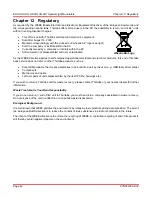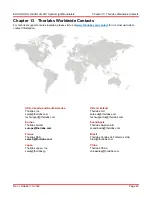
EXULUS-HD1 & EXULUS-4K1 Spatial Light Modulators
Chapter 7: Application Note: Displaying CGH Patterns
Rev I, October 18, 2022
Page 35
7.2.
Effects of Focusing and Tilt
Due to the fill factor of the SLM panel, there is a small gap between the pixels. This in turn causes higher diffraction
orders and a high-energy zero-order spot which is unaffected by the SLM, but inherently exists at the output. The
center bright spot often overlaps with the holographic projection on the same image plane, as is visible in Figure
33. It is highly preferable to remove this zero-order-spot in many applications.
In order to further enhance the holographic image, one can adjust the focusing effect added to the CGH pattern.
This causes the CGH projection to focus itself without the requirement of imaging lenses. Since the zero-order spot
is not affected by the focusing parameter, the CGH projection will form an image while the zero-order spot remains
collimated at the original beam size. Figure 34 shows the focusing effect that is added to the CGH as well as the
final processed CGH pattern sent to the SLM panel; in this example, the focal length was changed to 100 mm in
the software; the other software settings remained unchanged.
a. b.
Figure 34 a. The 100 mm Fresnel lens focusing effect added to the CGH pattern. b. The resultant
CGH pattern of the image in Figure 32 a, including the 100 mm focus, generated by the
“Spatial
Light Modulator” software.
If the imaging lenses used in the first example above are inserted into the beam path again, then the center bright
spot can be made to diverge while the holographic projection is refocused. This can be accomplished by following
these steps:
1. Generate a CGH pattern using a short focal length setting (here, we use 100 mm; other settings remained
unchanged from the first example).
2. Find the location where the CGH pattern is in focus, which should be at the distance set in the SLM software
(100 mm).
3. Put the first lens a short distance after this focused spot (here, we used an f = 50 mm lens).
4. Fix the location of the viewing screen at the desired location, and then insert the second lens into the beam
path (here, we used an f = 75 mm lens). Adjust the position of this lens until an image begins to form on the
screen.
5. Once the image of the CGH projection is found, make small adjustments to the position of both lenses to
optimize the size and clarity of the image.
The experimental setup is shown in Figure 35; note the lenses are in different positions than they are in Figure 31.
The resulting holographic projection is shown in Figure 36.










































